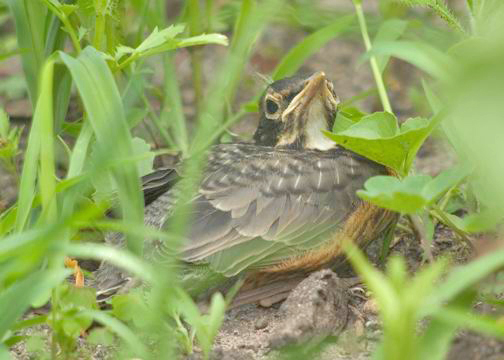Keep Kitty Indoors!
Birds and
other wildlife face more obstacles to their survival than ever before.
Wildlife habitats are destroyed and degraded every day, and many species
are declining as a result. Because human activities are changing natural
environments, the impacts of natural predators on their prey are changing.
And introduced or unnatural predators — like domestic cats — also
have a huge impact on survival of some species.
Cats Aren't Natives
You may be surprised to learn that the domestic cat is not native to the Western
Hemisphere. European immigrants introduced cats in North America only a few
hundred years ago. Domestic cats are descendants of the wild cats of Africa
and southwestern Asia. As such, they instinctively hunt and capture prey. However,
wildlife in the Western Hemisphere did not evolve in the presence of cats,
and so did not develop defenses against them.
When Birds are Most in Danger
During migration,
birds are particularly vulnerable to predators. They are unfamiliar with
their surroundings, and are tired and hungry after the long journey. This
makes the birds perfect prey for a cunning cat roaming outdoors.
Newly Fledged |
But cats
are dangerous predators for birds at other times of the year, too. For
example, most young birds leave the nest before they can fly well. Whenever
you see newly fledged baby birds on the ground taking short practice flights,
you'll know the young birds are easy prey for outdoor cats.
Do the Math
Scientists estimate that cats kill hundreds of millions of birds and three times
as many small mammals each year. Most of the birds are common species, such as
the Northern Cardinal, American Robin, or Song Sparrow. But others, such as the
California Least Tern or the Piping Plover, are rare or endangered. ALL wild
creatures suffer when captured by a cat. Dr. Stanley Temple, a professor of wildlife
ecology at the University of Wisconsin, made some startling estimates for his
state: Cats kill at least 9% of Wisconsin's summer bird population.
His research showed there are:
18.9 million adult birds at beginning of the breeding season
16.1 million more young birds are born each summer
35.0 million birds total
Of these:
3.25 million birds are killed by cats!
With over 65 million cats in the U.S. alone — 1 cat for every 4 people — imagine the toll they take on songbirds each year! By letting our cats outside, we are placing a higher value on the freedom of our pets than on the lives of the cardinals, robins, baby rabbits, or chipmunks that our cats kill.
|
Did You Know? |
|
|
|
|
You Can Help the Birds!
- Keep housecats in the house.
- Support efforts in your community to protect wildlife and their habitats.
- If you feed birds in your yard, locate feeders away from windows and brushy vegetation that gives neighborhood cats a place to hide.
- Keep your bird feeders clean and well stocked.
- Where possible, establish a brush pile for wildlife shelter away from feeders.
- Avoid using pesticides.
- Even if you don't have a cat, share this information with people who do.
Be a Responsible Cat Owner
|
Photo Laura Erickson |
American Bird Conservancy
1834 Jefferson Place, NW
Washington, DC 20036
Not Just
For the Birds
Keeping cats indoors isn't just for the birds. It's also for the cats. Cats
that roam outdoors are constantly in danger from cars, animal attacks, human
cruelty, overpopulation, disease, parasites, poisons and traps. The average
life expectancy of an outdoor cat is just two to five years, while an indoor
cat may survive for 17 or more years.
ABC reminds you that cats that roam outdoors can be turned into happy indoor
pets if you provide a safe, outside enclosure, such as a screened porch, where
they can "see but not touch." Please start today! Indoor cats may
slip out an open door before you know it, so keep in mind the other essentials
of responsible pet ownership:
- Spay or neuter your kitten as early as eight weeks of age.
- Provide routine veterinary care, including annual check-ups and vaccinations.
- Put an identification tag on your cat's collar. It will be her ticket home in case she slips outside.
- Take cats for which you cannot care to your local animal shelter to give them the best possible chance of adoption into loving, lifelong homes.




